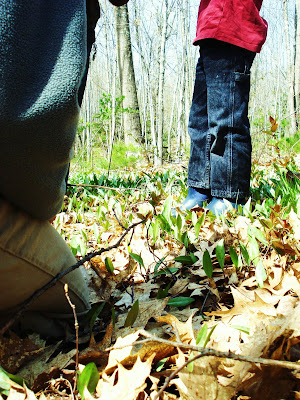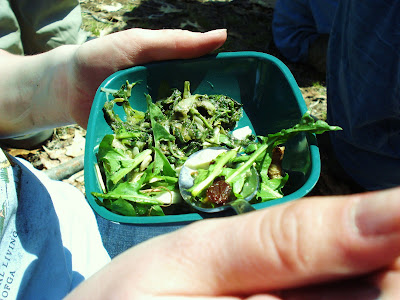
As usual, Chris had us gather for a welcoming song, this one about Mother River. He then told us that we would spend some time learning to identify edible plants that are readily availble in the woods. We would then learn to prepare the greens for our lunch. In his way, Chris urged us to be mindful of the gifts the Earth offers and to be careful not to harvest too much from one area. The first plant he had us identify was trout lily (Erythronium albidum).


After learning about trout lily, we were able to identify it fairly easily as it was quite abundant. As the leaf, stem and root are edible, (and Chris cautioned, with education and small portions at first) we all ate some. Some of us found it spicy, some said it tasted like beans, or peas or mesclun. It seemed that most liked it just fine. We each picked on leaf and added to Chris's collection basket; later we would have the leaves for lunch.


Next we went up to the edges of the farm fields to look for dandelion (Taraxacum officinale), yellow dock (Rumex crispus) and wild carrot (Daucus carota), also known as the root of Queen Anne's Lace. Our simply made digging sticks were very useful in digging up the sometimes stubborn roots of both the dandelion and wild carrot.



With a little effort, we had quite the mess of greens that would be used for our afternoon meal.




Given that the newly dug roots had only grown in the ground moments before, we thought it would be good to wash them in the nearby stream, while others in the group gathered firewood. The meaningful work of washing the roots soon became an adventure as some roots were seperated from the child to be carried off down stream into cool brown eddies. The roots were rescued, feet and bums were sacrificed to the wet and soon we had freshly scrubbed roots ready for the next steps in meal preparation.



In addition to the foods we were able to collect in the woods, Chris also brought some harvested foods from home for us to add to our meal. One of these foods was the hated Japanese knotweed (Polygonum cuspidatum). Though the bamboo-like stalks become too woody to eat later in the season, they are very edible and a fine alternative for rhubarb. As Chris said "it benefits from a little sugar". He used his own maple syrup for sweetening the knotweed sauce before adding it to his pressed pie crust in a cast iron skillet.


While some the kids and parents chopped knotweed, the others tended the fire or made the wild green salad, with a few things from Chris's home added, like a winter cached cabage, dried grapes and sunflower seeds. The dandelion greens were boiled down and drained, then Chris added some sharp cheese and butter to make a dish reminiscent of saag paneer, minus the paneer and curry. With the salad and greens prepared, it was time for our meal.



We had plenty of food to go around and there lots of comments about the flavors. There were many requests for seconds, thirds, fourths...



As we finished our lunch and packed up our supplies, Chris recommended some books on foraging for edible wild plants. This book in particular, Chris likes, though all are useful.

With that, our wild greens day came to an end. However, as a thank you to the farmers of Broadturn Farm for inviting us to use the land for the Earth Is Our Home, we would help plant potatoes. Though different in many ways, this lesson seemed a very fitting end to a day of harvesting from the land--here we were, putting something back, just yards from the woods where we ate our wild greens. As it was generous of John and Stacy to share the land with us, it was equally generous of them to allow all of us to contribute to the workings of the farm. It's not an easy thing to give over the planting of precious crops to a crowd of people, so for my part, I am grateful to them. We all worked to spread compost in the furrows, and cut potatoes to ready them for planting. After learning about proper spacing, the kids hauled heavy buckets of potatoes up and down the field, planting one every 12 inches or so. If Stacy of John came along behind and really spaced the potatoes 12 inches, well, I didn't notice.









We had company, of course, as the goose looked on, perhaps intolerant of our methods in potato planting.

With guidance from Chris, Olivia and Sammy designed a thank you card for the farmers and everyone signed it. It was handed over with a little extra dirt, but I'm confident they didn't mind, not a bit.

Yes, what a good day. Lots of meaningful work, sunshine, good food, good company, new skills learned, new friends made-- nothing could be better. We did miss Ashirah and Owen who stayed home to do some of their own spring chores on their homestead, but we'll see them this Saturday when we participate in the final Earth Is Our Home session, this time an overnight trip. With a grateful heart, thanks again, to the Knapps to our homeschooling friends and to our community.
wow! that is amazing. i think logan and audrey would have loved that. i know i would have. i am so interested in that stuff. i will have to look for that book. great pics!
ReplyDeleteSo nicely documented, Amy! It was a great day. Can't wait to see those taters growing, just about when we return to pick strawberries at the farm!
ReplyDeleteLooks like an amazing day.
ReplyDeleteAnother wonderful lesson from the Knapps!
ReplyDeleteI remember planting potatoes with my dad. I asked him "Why can't we just eat these potatoes?!"
The sky in the first photo is an amazing blue!
What a great experience! We are learning so much about the woods and all it has to offer! How fortunate that you have such knowledgable people close by the share natures bounty!
ReplyDeleteThanks for the book link! We have one specific to Eastern Canada but would like a more detailed resource!